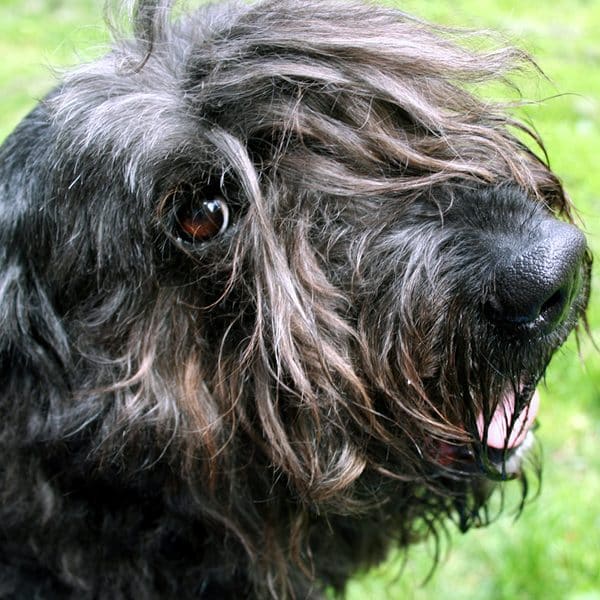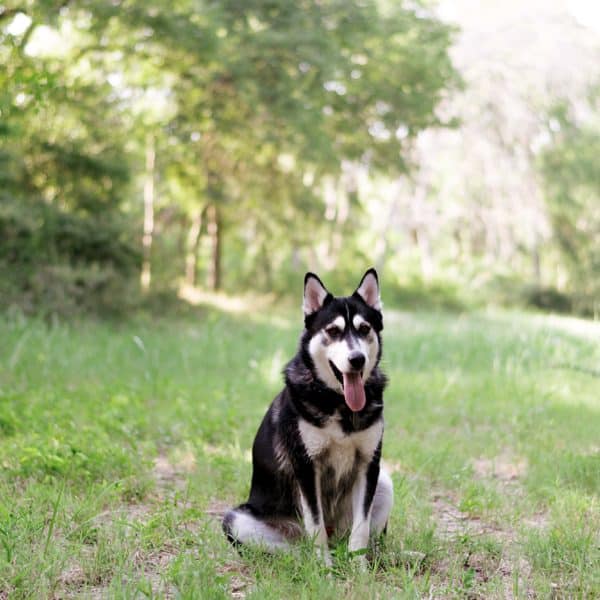Dogs of all sizes can really project when they want to, so I started researching the canine larynx and vocal cords. Like all mammals, dogs are subject to the ravages and physical decline that accompany advancing age. These include changes to the tone and pitch of their voices. Their barking becomes hoarse.
If I find my own dog slightly annoying during her late-night barking campaigns, I’d be startled to notice any change in the volume or tenor of her voice. My researches led me to laryngeal paralysis, a condition affecting the voice box of some larger dog breeds as they age.

Do dogs have vocal cords?
Yes! Dogs’ vocal cords enable them to make the range of vocalizations any dog owner is familiar with. The vocal cords vibrate as air from the lungs passes out of the trachea, or windpipe, and through the larynx, or voice box. Tiny dogs make shrill, high-pitched sounds, while giant breeds have booming, stentorian voices. Like wind instruments in an orchestra, the differences in pitch are due to the size and diameter of the larynx.
What is a larynx?
In dogs, and most other mammals, the larynx is an organ made of cartilage, nestled between the windpipe and the mouth. It is not only the origin of the sounds we make, but also serves a protective function. The cartilage is buttressed by muscles that expand and contract to allow oxygen in when animals inhale, and expel carbon dioxide when they exhale.
A dog’s vocal cords are made up of mucous membranes and some small muscles. They are thin tissues anchored to the cartilage and muscles of the larynx. Their vibrations produce all of the noises and sounds we associate with canine vocalizations, from whines and whimpers to barks and howls. Muscles at the base of the larynx open to allow air in and out, and close to redirect food and water into the esophagus.
Laryngeal paralysis in dogs
Any medical phenomenon — including aging, disease, or physical trauma — that affects the normal operation of the larynx can cause noticeable changes in the sound of a dog’s voice, in other words, it’s becoming hoarse. Laryngeal paralysis is among the most severe and potentially life-threatening forms of laryngeal disease in dogs. Colloquially known as “lar par” in the veterinary profession, this condition involves the malfunction or corruption of the nerves and muscles that open the airway. That pathway has little doors, called the arytenoid cartilages, on either side, that the muscles control.

Respiration is part of the autonomic nervous system. In the larynx, nerves fire, telling the muscles to move the arytenoid cartilages accordingly. When the nerves cease delivering those messages, the muscles cease to work properly, and they become weakened. In this case, “paralysis” isn’t a stiffening or rigidity, but the opposite; unstimulated, the muscles atrophy. Over time, paralysis of these muscles can lead the cartilage that forms the overall structure of the larynx itself to degenerate. Suffocation and death can result if the condition is severe and left untreated.
What causes lar par in dogs?
Genetics can be the reason for a dog to experience laryngeal paralysis, but it is a rare one. Genetic predisposition to lar par is thought to affect the following dog breeds:
- Bouvier des Flandres
- Bulldogs
- Bull Terriers (English and Staffordshire)
- Dalmatians
- Leonbergers
- Rottweilers
- Siberian Huskies
This is rare, and still poorly understood for most of these breeds. According to PetMD, in this form of laryngeal disease the precise genetic source has only been isolated in the Bouvier des Flandres. Depending on the breed, male puppies in particular may start displaying symptoms as early as 11 weeks, or as late as 8 months.
One unfortunate fact about laryngeal paralysis is that the overwhelming majority of diagnosed cases are acquired and idiopathic, the latter term meaning that the cause is unknown. Like the inherited form, though, the acquired disease affects more male than female dogs, and seems, for the most part, to be linked to age. The breeds most often diagnosed include:
There’s a definite pattern among the inherited and acquired forms of lar par, disproportionately affecting large and giant breeds. As an idiopathic condition, it’s impossible to pinpoint a specific reason why the muscles in dog’s larynx become less effective, though there are many possibilities.

Muscle weakness and nerve degeneration could be linked to thyroid issues, neurological disorders, cancerous and non-cancerous growths, and physical trauma. Some sources make admittedly tenuous links between trauma to afflicted dogs’ necks and throats and the use of choke collars or repeated leash-pulling. Even if this last link is only speculative, it may be worth switching large and giant dogs to harnesses.
Symptoms of canine larynx paralysis
The acquired form of laryngeal paralysis may have a long tail; the nerves and muscles in the larynx can start degenerating years before symptoms become worrisome. In older dogs, especially representatives of the breeds listed above, the most obvious symptom is a change in the sound and strength of a dog’s bark. After years of normal vocalizations, a dog might start to sound oddly hoarse or raspy.
Gradual alterations to a dog’s voice, whether in strength or pitch, are only one signal that a dog is struggling to get oxygen. Early in its development, dogs may exhibit no changes at all but shortness of breath or a cough. During the summer months, older and larger dogs may tire faster than usual following very little exertion. Panting can become extreme quickly and a dog might seem to be gagging or gasping for air.
Diagnosis, prognosis, and approaches to treatment
Many of these symptoms are common enough in aging dogs, an actual case of laryngeal paralysis can go unnoticed and undiagnosed until it is far advanced. Regular veterinary visits can help your dog’s vet trace potential warning signs from an early stage. If they begin to notice problems, there are a number of approaches to diagnosis, including blood and urine tests, X-rays or ultrasounds, and, in particularly troubling circumstances, sedation may be called for to get a direct visual look at the larynx.
In cases that are severe or threaten to become that way in time, surgical intervention can yield a positive prognosis for a dog. One of the arytenoid cartilages, mentioned earlier as the doorways that open and close the larynx, is effectively pinned or tied back with stitches. This allows air to go in and out more easily. Since acquired laryngeal paralysis tends to affect senior dogs, a successful tie-back surgery leaves most dogs free to live out their natural lives without further complications.









